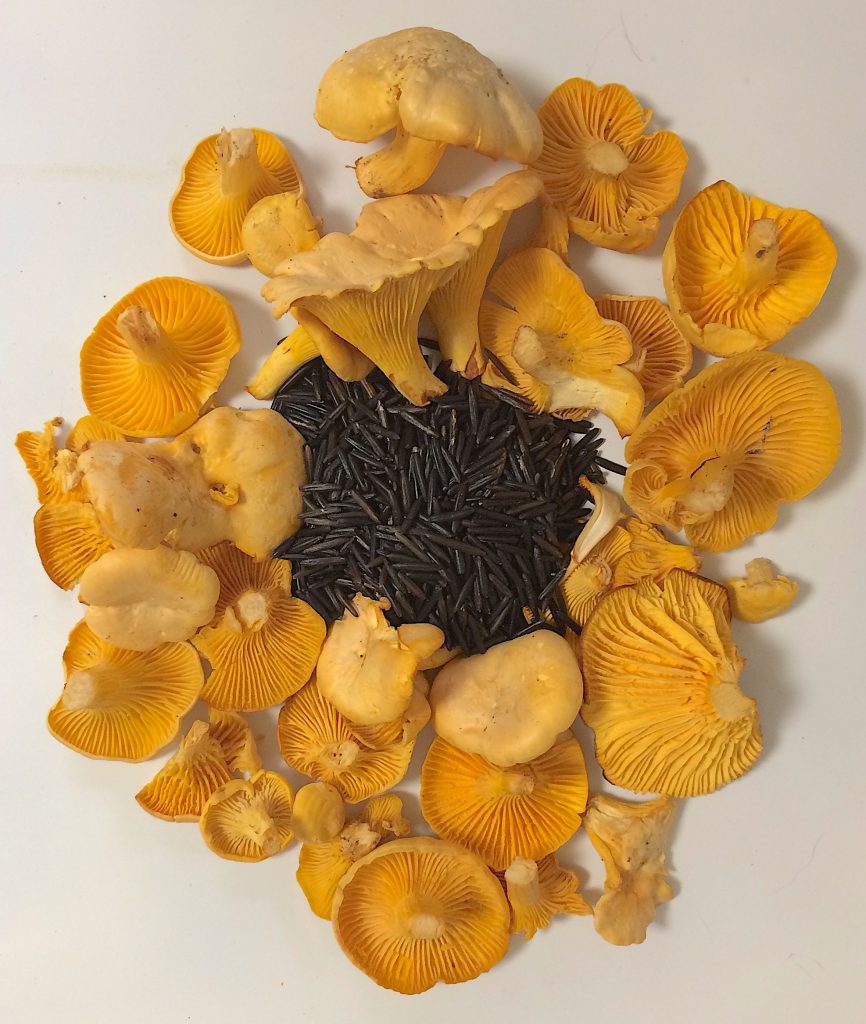
Wild Chanterelles and wild rice. Photo by Green Deane
It was a mushroom Saturday. After our foraging class we went mushroom hunting and took home pounds of chanterelles, Old Man of the Woods, and milk caps. There were more Old Men than I had even seen. I had some chanterelles with scramble eggs and ghee for breakfast this morning. There are some 81 edible species of mushrooms in Florida and our best season is after late spring or early summer rains.
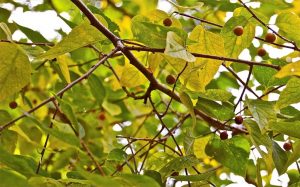
Sugarberries/Hackberries are starting to ripen.
There is a tree you should be scouting for now so when the fruit ripens next month you’ll have some already located. As in real estate so in foraging: Location, location, location. Hackberries (also widely know as Sugarberries) like to be near but not in fresh water. You can often find them about 10 feet above the local water table but I’ve seen them as low as three feet. Usually you can find them up the bank from the water. Older Hackberry bark will often be warty, sometimes heavily so. Leaves have uneven shoulders, and on the back side of the leaf notice three prominent veins at the base, unusual for tree leaves. The small-pea sized fruit is green now but will ripen this month or early September into a burnt orange. The entire fruit is edible though the seed is hard. To read more about them go here.
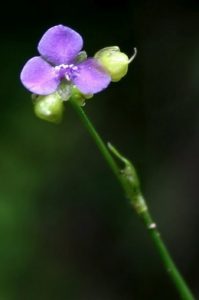
Murdannia nudiflora,
Doveweed, Murdannia nudiflora, might be the smallest non-floating edible plant in the United States. Barely known, easily overlooked, yet very invasive. It pays to be small. For some young Doveweed is prime for soups, others view it as famine food. I can understand that. It’s closely related to a genus that gives me an upset stomach, the Commelinas (Dayflowers.) I use only Doveweed blossoms in my salad. To anyone used to finding Dayflowers the Doveweed will look familiar but only a few inches tall. It also has a lot of common names around the world including “Micky Mouse.” To read more about the Doveweed, go here.
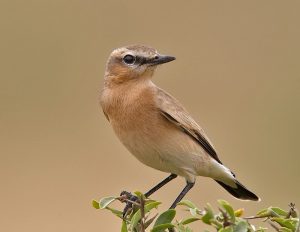
Isabelline Whetear
To my knowledge I’ve never met anyone named Isabell. So when the word “isabelline” cross my optical path about plants I had to look into it. “Isabell” means “God’s promise” presumably a positive one. It was very popular girl’s name in the 1880s, all but disappear until 2003 whereupon it had a resurgence in popularity until 2007. Now it is on the wane again. But what is isabelline? There are three application of which I have also apparently never heard of. One is what we could call Spanish Gothic Architecture. King and queen Ferdinand and Isabella got Columbus launched then turned to building cathedrals and the like. That style is called Isabelline, properly capitalized. I’m surprised they didn’t called it Ferdinine. The second use is a color: Isabelline. A color? Yes, and the word has been in use for at least 400 years so it is not a paint-store invention like “Baby Fawn.”
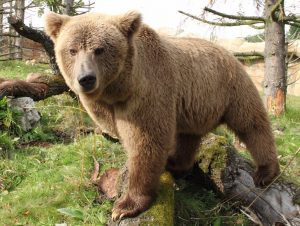
A Himalayan Brown Bear (Ursus arctos isabellinus.)
Isabelline “means a light yellow-gray and used mostly to describe mushrooms, animals and birds. There is the Isabelline Wheateater, see above right, the Isabelline Shrike, and the Isabelline Bear, left. Horses that are a cross between a Golden Palomino and a Champagne Palomino are also called Isabelline. Now, what of the third use? Well… ahem….Isabelline is also a reference to faded underwear. The story comes from when Philip II of Spain laid siege to the berg of Ostend in 1601. His daughter, Isabella, Archduchess of Austria, made a rather presumptuous vow not to change her underwear until the city was taken, thinking dad would be home by supper, lunch by Sunday for sure… Unfortunately for Isabell — and those around her — the siege took three years. Thus the color of dingy underwear is “isabelline.”
Foraging classes: My Saturday’s class — Sarasota — is a couple of hours closer for me. My Sunday class –Gainesville — will be nearly a five hour drive for me, such is the results of moving.

Foraging classes are held rain or shine, heat or cold. Photo by Nermina Krenata
Saturday, August 6th, Red Bug Slough Preserve, 5200 Beneva Road, Sarasota, FL, 34233, 9 a.m. Meet at the playground.
Sunday, August 7th, Boulware Springs Park, 3420 SE 15th St., Gainesville, FL 32641. Meet at the picnic tables next to the pump house. 9 a.m.
Saturday, August 13th, John Chestnut County Park: 2200 East Lake Road, Palm Harbor, FL 34685. Meet at the trail head of the Peggy Park Nature Walk, pavilion 1 parking lot. 9 a.m.
Sunday, August 14th, Bayshore Live Oak Park, Bayshore Drive. Port Charlotte, meet at the parking lot at Bayshore and Ganyard Street. 9 a.m.
For more information, the pre-pay for a class, or sign up go here.
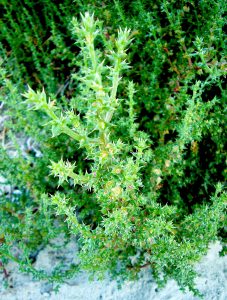
I find Russian Thistles in front of hotels on Daytona Beach. Photo by Green Deane
We shouldn’t forage along railroad tracks and you can blame it all on the Russian Thistle. This species, best known as the tumble weed that rolls across the wild west in movies, came with immigrants to southern South Dakota in the early 1870’s. Best guess is it contaminated their flax seed. By 1895 it reached New Jersey and California. The question was how? A professor who worked for the Department of Agriculture figured out the trains were spreading the seeds coast to coast. It was a remarkable idea at the time and brought him much fame. His solution to the unintentional distribution? Kill plants long railroad tracks. Thus began the practice of putting down some mighty and long-lasting chemicals to kill weeds sprouting amongst the iron rails. Railroad tracks are a good place to find seeds to take home and plant but not to find food. There have even been a few reported deaths from foraging along rail road tracks.
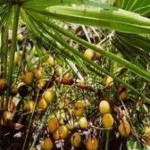
Saw palmetto berries half way to ripe.
As we are inching into August and Saw Palmetto Berries are turning from green to gold. In another month they will be black and edible (so to speak.) Many folks find the flavor of Saw Palmetto berries revolting. I am not sure they are an “acquired” taste or a tolerated one. You will either be able to eat them or not. Basically they tastes like vomit. To be a little more gracious they taste like intense blue cheese with some burning hot pepper tossed in. Once you get used to them they are… endurable. But if you were hungry you would crave them in that they have all the amino acids humans need to be healthy. They are good for you even if you don’t like them. As with some fruit — Durian for example — the smell is enough to dissuade many people from eating them. Saw Palmetto berries will be ripening for the next month or so thus you have plenty of time to try one.

You get the USB, not the key.
Changing foraging videos: As my WordPress pages are being updated the video set will go away. They are the same videos I have on You Tube. Some people like to have a separate copy. The DVD format, however, is becoming outdated. Those 135 videos plus 36 more are now available on a USB drive. While the videos were played from the DVDs the videos on the USB have to be copied to your computer to play. They are MP4 files. The 171-video USB is $99. If you make a $99 “donation” using the link at the bottom of this page or here, that order form provides me with your address, the amount — $99 — tells me it is not a donation and is for the USB.

Green Deane Forum
Want to identify a plant? Perhaps you’re looking for a foraging reference? You might have a UFO, an Unidentified Flowering Object, you want identified. On the Green Deane Forum we — including Green Deane and others from around the world — chat about foraging all year. And it’s not just about warm-weather plants or just North American flora. Many nations share common weeds so there’s a lot to talk. There’s also more than weeds. The reference section has information for foraging around the world. There are also articles on food preservation, and forgotten skills from making bows to fermenting food.
This is weekly newsletter #518, If you want to subscribe to this free newsletter you can find the sign-up form in the menu at the top of the page.
To donate to the Green Deane Newsletter click here.


Do you know how long those chemicals last after they stop spraying? We have a number of defunct rail lines in the area that haven’t been used in over 20 years.
Very good question, Karine, as I have a similar situation in TN. In some areas the line has been so absorbed by nature that only memory tells its location. But I would still only use it as a seed source, as Deane recommends. But still, good to explore and know for future use.
Deane,
Please disregard my earlier comment regarding hackberry trees. I realize now this may be controversial as many others seem to find it a useful tree. I read your previous article on this subject and read all the comments and found some ideas I would like to explore more fully. There may yet be salvation for this tree.
Thank you.
Danny